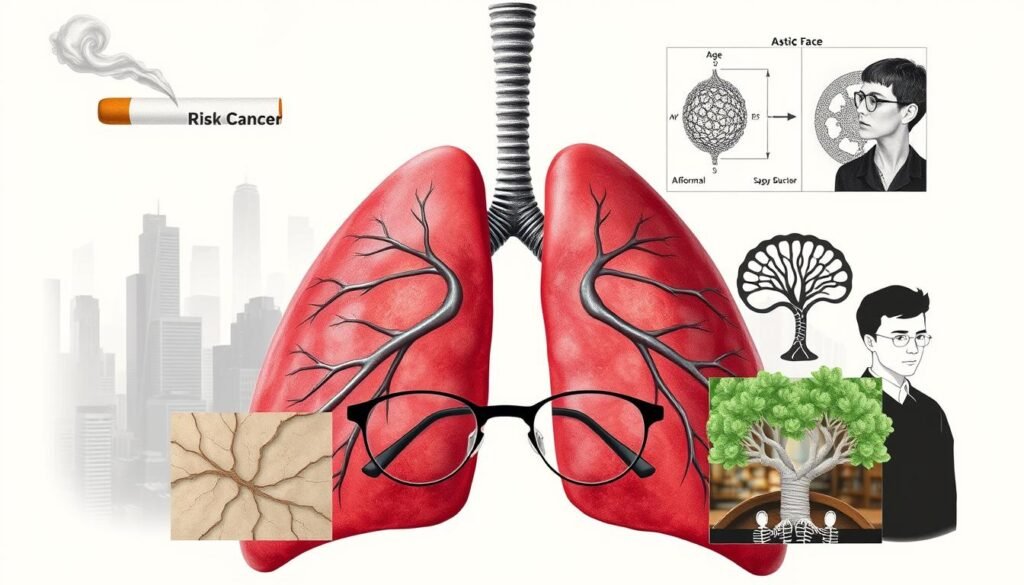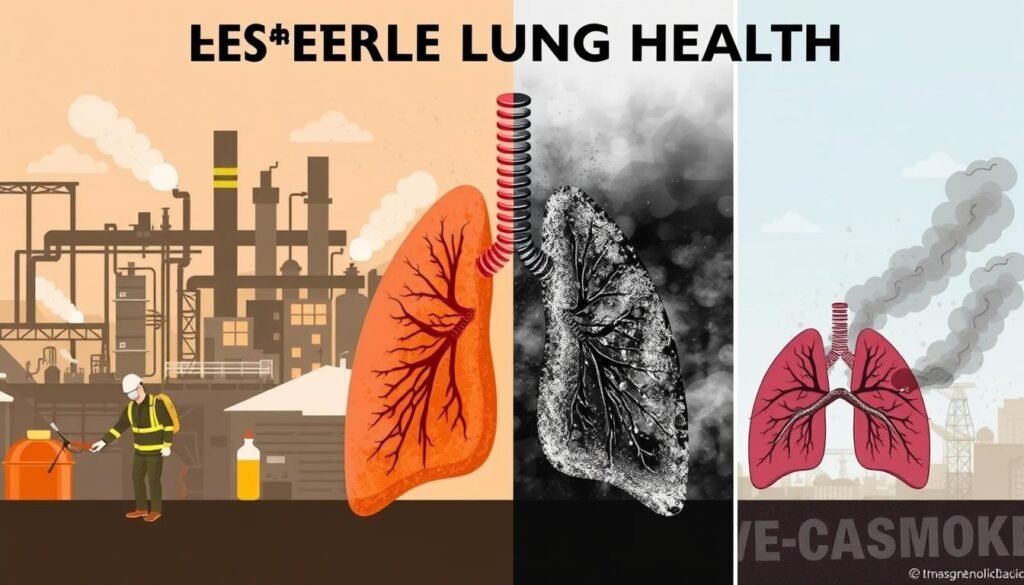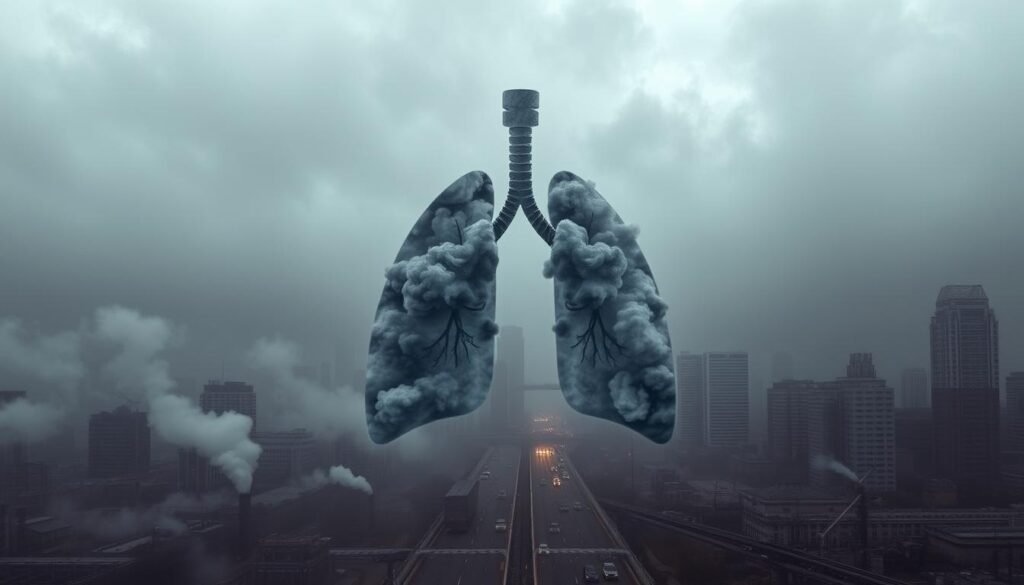Did you know a person’s smoking history greatly affects their lung cancer survival rates? About 70% of stage IIIB/IV Non-Small Cell Lung Cancer (NSCLC) patients have smoked more than 15 pack years. This fact sheds light on the grave health risks of long-term smoking. It also shows why knowing your smoking history is important. This article will help you understand what pack years mean and how they relate to lung cancer risks. It will discuss the impact of smoking on lung health and survival too.
Key Takeaways
- The risk of lung cancer for those with 15 pack years is significantly elevated.
- Lung cancer primarily affects smokers, accounting for 85% of cases.
- Understanding smoking history is vital for determining patient prognosis.
- Longer smoking history correlates with decreased median survival rates.
- Awareness of lung cancer risks can lead to early detection and better outcomes.
- Screening eligibility remains a critical issue, especially among racial groups.
- Quitting smoking greatly improves health outcomes, even post-diagnosis.
Understanding Pack Years
Understanding pack years is key to knowing how smoking affects lung health. It measures a person’s smoking in terms of how long and how much they’ve smoked. Knowing someone’s pack years helps doctors figure out their risk of lung cancer and other diseases from smoking.
Definition and Calculation of Pack Years
A pack year means smoking one pack of cigarettes every day for a year. To find out pack years, use this formula:
- Number of packs smoked daily (N) × Number of years smoked (T) = Pack years (PY)
Here’s an example:
| Daily Packs Smoked | Years Smoked | Pack Years |
|---|---|---|
| 1 | 20 | 20 |
| 2 | 30 | 60 |
| 0.5 | 30 | 15 |
Importance in Assessing Lung Cancer Risk
Pack years play a big role in determining lung cancer risk. More pack years can lead to more health problems like lung cancer, heart disease, and others. Women might get lung cancer with fewer pack years than men. This is because they’re more sensitive to cigarette smoke.
Knowing about pack years helps doctors understand a patient’s risk better. However, they also look at the smoker’s full history. This includes when they started smoking and for how long.
Risk of Lung Cancer for Those with 15 Pack Years
Smoking history is closely linked to lung cancer. Studies show that smoking 15 pack years or more greatly increases lung cancer risk. This risk is much higher than for non-smokers. Even those who smoked moderately are at elevated risk.
Among everyone, current smokers represent 5.0% of lung cancer cases if they’ve smoked less than 20 pack years. People who quit smoking still face risks. After 15 years without smoking, their lung cancer rate is also 5.0%. This info helps us understand the dangers of past smoking.
Statistical Insights on Lung Cancer Incidence
Research gives us a clear warning signal. Former smokers who quit 15 years ago still face high lung cancer risk. They have a hazard ratio of 10.22 compared to non-smokers. This shows quitting doesn’t immediately drop lung cancer risk to zero.
After following participants for over a decade, the need for better screening guidelines is evident. We must not overlook former smokers when considering lung cancer risks. They need tailored screening to catch any potential issues early.
Pack Years and Broader Cancer Risks
Pack years link to more than just lung cancer. They also increase the risk of mouth, throat, and bladder cancers. Smoking long-term can even lead to heart disease. Understanding these links can help shape health policies and screening methods.
This is especially important for those who used to smoke. Expanding screenings for them, even after 15 years, is critical. Improved screening could reduce lung cancer’s impact. Highlighting research on lung cancer screening is key to saving lives.
| Category | Incidence Rate | Hazard Ratio |
|---|---|---|
| Current Smokers ( | 5.0% | 10.54 |
| Former Smokers (20+ pack years, 15+ years cessation) | 5.0% | 10.22 |
| Never Smokers | 0.5% | N/A |
Key Lung Cancer Risk Factors
It’s important to know the risk factors tied to lung cancer for prevention. Smoking is the biggest cause among these factors. The choice to smoke can greatly affect one’s chance of getting lung cancer. Being around secondhand smoke and having genes that make you more likely to get lung cancer are also big risks. Understanding how these risks work together helps in finding ways to prevent lung cancer.
Smoking History and Its Impact
About 80% of lung cancer deaths come from smoking. This makes it the top risk factor. People who smoke now are at the biggest risk. Research shows that women might get lung cancer after smoking fewer cigarettes than men do. This highlights the impact of how much and how long one has smoked. To learn more about the effects on cells, check out this detailed guide.
Role of Secondhand Smoke Exposure
Being around smokers can also cause lung cancer and is the third leading cause in the U.S. If you don’t smoke but often are near those who do, your risk can go up by 30%. The dangerous particles in secondhand smoke are just as harmful as smoking yourself. Spreading the word on how bad secondhand smoke is can help lower tobacco use everywhere.
Genetic Predisposition to Lung Cancer
Genes can also affect your risk of getting lung cancer. People with certain genes are more at risk. This is especially true if they smoke or started smoking young. Having these genes and being around smoke makes lung cancer more likely. Dealing with lung cancer means looking at both genes and lifestyle choices.

Impact of Occupational Hazards on Lung Health
Work environments pose big risks to our lung health, leading to diseases including lung cancer. Workers in construction, mining, and manufacturing sectors often deal with harmful substances like asbestos and silica dust. These substances can increase the risk of lung cancer, especially if someone smokes too. It’s crucial to understand these dangers to protect workers and increase awareness.
Common Occupational Carcinogens
Many jobs expose people to things that can cause cancer. Below is a table showing some of these cancer-causing substances and the risks they bring:
| Carcinogen | Common Sources | Associated Cancer Types |
|---|---|---|
| Asbestos | Construction, shipbuilding | Lung cancer, mesothelioma |
| Silica Dust | Mining, stone cutting | Lung cancer, silicosis |
| Diesel Engine Exhaust | Transportation, construction | Lung cancer |
| Polycyclic Aromatic Hydrocarbons | Steel production, coal tar | Lung cancer |
Workers’ Compensation and Lung Cancer Risks
Workers with lung cancer from their jobs often look for workers’ compensation. This helps with their treatment costs and more. But, proving the cancer came from their job can be hard. Having good rules and records helps fight for these workers. Knowing about lung cancer risks in different jobs is crucial for prevention and support.

Air Pollution and Its Link to Lung Cancer
Studies have shown a strong link between air pollution and lung cancer. This link points out how our environment plays a part in lung cancer risks. Pollutants like fine particulate matter and nitrogen oxides are major factors in the rise of lung cancer.
The Role of Environmental Factors
Air pollution’s long-term effects can be as harmful as chronic smoking. Nitrogen dioxide levels going up by 10 µg/m3 increase lung cancer mortality risk by 3%. Another key pollutant, PM2.5, raises lung cancer risk by 16% with a 10 µg/m3 increase. Car emissions and industrial activities fill the air with toxins, affecting lung health.
Long-term Studies on Air Quality and Lung Health
About 10% of lung cancer cases in places like the UK come from outdoor air pollution. Shockingly, air pollution causes nearly 6,000 non-smokers to die of lung cancer each year. With 99% of people living where PM2.5 levels are too high, it’s crucial to look into air quality for public health. Raising awareness and taking action against pollution is key. For more details on air pollution’s effects on lung cancer, click here.

| Pollutant | Hazard Ratio | Effect per Increase |
|---|---|---|
| Nitrogen Oxide | 1.15 | per 50 ppb |
| Nitrogen Dioxide | 1.12 | per 20 ppb |
| Fine Particulate Matter (PM2.5) | 1.20 | per 10 µg/m3 |
| Carbon Monoxide | 1.29 | per 1,000 ppb |
| Regional Benzene | 1.17 | per 1 ppb |
Screening Guidelines for Lung Cancer
It’s crucial to understand lung cancer screening guidelines for people at risk. Especially for those who have smoked for 15 pack years, the risk is higher. Annual screenings are key for early detection. This could lead to better survival rates and treatment success.
Who Should Get Screened?
The U.S. Preventive Services Task Force gives clear screening guidelines. They recommend yearly low-dose CT scans for those aged 50 to 80 who have smoked at least 20 pack years. If you’ve smoked for 15 pack years, the advice might change. Knowing your smoking history is vital. It helps when talking to doctors about lung cancer risks and screening benefits.
Recommended Screening Techniques
Low-dose CT scans are now the top choice for spotting lung cancer early. They give clearer images than old X-ray methods. Studies show that these CT scans lower the death rate by 20% in screened patients. Following these guidelines helps doctors catch and treat lung cancer sooner. This is especially true for people with a 15 pack year history.
Smoking Cessation Programs
Quitting smoking is key to lowering lung cancer risk and bettering health. Studies confirm that stopping smoking greatly reduces the chance of getting illnesses caused by smoking. Quitting early is very effective. People who stop smoking before 40 can greatly cut their risk of dying from smoking-related illnesses.
Benefits of Quitting Smoking Early
Starting a smoking cessation program early has many advantages. These benefits include:
- 50%-80% reduction in lung cancer risk for recent quitters and former smokers.
- A big improvement in the rate of quitting among lung cancer patients compared to non-patients. About 80.6% of diagnosed patients quit. This is much higher than the 45.4% rate among those not diagnosed.
- A decrease in second lung cancers for those who have quit.
- Major health improvements, with lung cancer risk dropping within five years of quitting.
Resources for Smoking Cessation
There are many resources to help quit smoking. These programs often include:
- Counseling services for personal support and tactics.
- Support groups sharing experiences and encouragement.
- Meds to ease cravings and withdrawal feelings.
- Programs recommended by doctors for effective quitting.
The American Cancer Society and many healthcare providers offer programs to help quit smoking. Using these programs can greatly increase the chance of quitting for good. It’s key to stay involved with these resources to beat the risks of smoking.
The Importance of Lung Cancer Awareness
Raising awareness about lung cancer is crucial. It helps improve early diagnosis and treatment. Knowing the symptoms allows people to seek help early. Key symptoms are a constant cough, losing weight without trying, and chest pain. Teaching people about these signs can help smokers take quick action. This helps tackle lung cancer risk factors efficiently.
Understanding Symptoms and Early Detection
Teaching about lung cancer signs leads to early detection. Lung cancer is a top cause of cancer deaths in the US. Recognizing its symptoms is key in lowering its toll. When people know what to look for, they’re more likely to get screened in time.
Racial Disparities in Lung Cancer Screening
Dealing with racial disparities in lung cancer screening is crucial. Studies show African Americans are often diagnosed late, in more advanced stages. By making outreach programs better and updating screening rules, we can treat everyone fairly. Focusing on this issue helps improve health equality and outcomes for those at risk.
| Race | Screening Rates | Diagnosis Stage at Discovery |
|---|---|---|
| White | 72% | Early |
| Black | 58% | Late |
| Hispanic | 65% | Early |
Conclusion
Knowing the risk of lung cancer with 15 pack years is crucial for good health. A lot of lung cancer cases are linked to smoking, especially in those who smoked for 15 pack years or less. Being aware of risks, screenings, and how to quit smoking helps a lot.
Quitting smoking can really lower your risk of getting lung cancer. Compared to those who keep smoking, people who reduce or stop entirely are much safer. So, stopping smoking is a key step for health.
Lung cancer screening is also very important. Screenings like low-dose computed tomography (LDCT) help find cancer early in high-risk people. This early detection can save lives. Sticking to yearly screenings is a good way to fight lung cancer.
Understanding how smoking affects lung cancer risk is empowering. By quitting smoking and using screening tests, you can greatly lower your cancer risk. To learn more, check out lung cancer screening options here. Also, see how less smoking helps your lungs here.